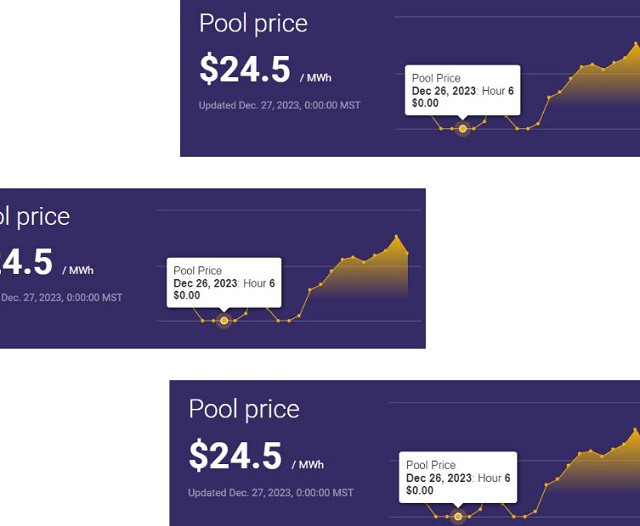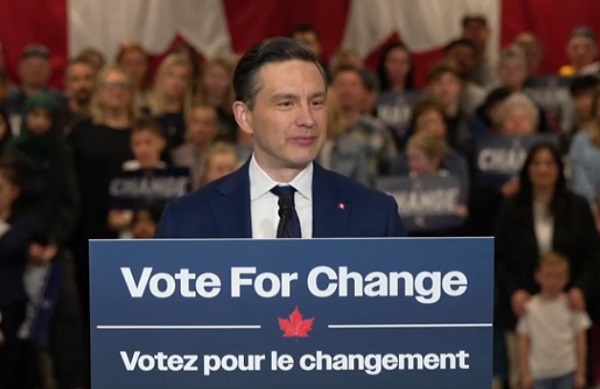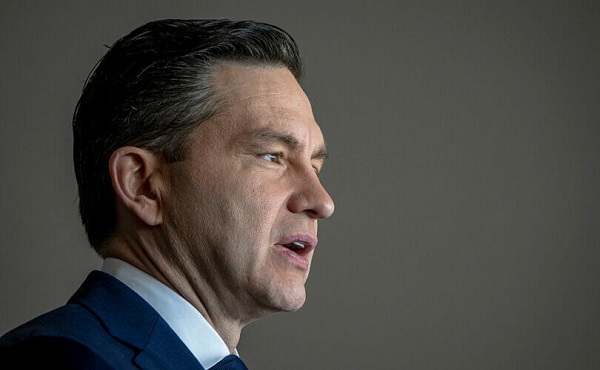Alberta
Boxing Day Special! Alberta had free power for several hours, and that’s not a good thing

From the Frontier Centre for Public Policy
Imagine, if you will, a Boxing Day sale where everything was free for everyone across every store at the same time, for several hours.
And imagine if in early morning hours of Dec. 26, Best Buy, Staples, Walmart, and indeed every single store in the entire economy got paid precisely zero dollars for their wares for several hours that morning.
Preposterous, you say!
Indeed, it did happen, in Alberta’s free-wheeling unregulated electrical market. The pool price, as recorded by the Alberta Electric System Operator (AESO) was $0.00 per megawatt at 4-7 a.m., and from 11 a.m. until noon.
And as a pool price, that means unless there’s some other contract going, that’s the price all generators get paid.
I might not have an MBA, but I’m fairly certain no business model in the world can survive getting paid nothing at all for their product for terribly long. If McDonalds, Burger King and Tim Horton’s all gave away their breakfasts on Dec. 26 to all comers, they couldn’t do it for long before someone would realize this is idiocy and shut the doors.
So what was happening during those wee hours in the morning, as the Boxing Day shoppers were in line for their flat screen TVs? It was quite windy in Alberta.
X bot account @ReliableAB, which logs hourly reports of the AESO minute-by-minute reporting of the grid showed that wind generation was just a hummin’. For several weeks, Alberta wind power has been been frequently pumping out high numbers, often in excess of 70 per cent of its nameplate capacity. One would think this would be a great thing, right? It’s finally doing what it’s supposed to do.
At 4:38 a.m., @ReliableAB reported Alberta’s now 45 wind farms were putting out 3,508 megawatts of the installed capacity of 4,481 megawatts while the pool price was zero.
At that point, wind was generating a full 33 per cent of total generation, which again, sounds like great news.
It was during one of the deadest periods of economic activity in the whole year, the night after Christmas. Demand in Alberta was low, with an internal load of 9,632 megawatts. The lack of demand happened to coincide with lots of surplus power being dumped onto the grid.
(As it was still dark, solar wasn’t a factor.)
What to do? How about sell as much as you can?
And that’s what happened. Alberta was pumping out 995 megawatts of power exports to its neighbours, 967 megawatts to BC, 26 to Saskatchewan, and two megawatts to Montana.
This situation is also the converse of what I’ve been reporting on over almost precisely 24 months, the frequent collapse of wind power generation in Alberta. Almost every time that has happened, the pool price shoots up, often hitting $700, $800, $900 or even the theoretical maximum of $999.99 per megawatt hour. If the maximum was $2,000, I’m willing to bet it would have hit those heights, too. And the integral under that graph – what consumers get on their bill – is horrendous.
So here we have renewable, “green” power in surplus, driving prices down for everyone, and so much so that it can benefit the neighbours, too.
But therein is the fundamental problem. No one, not Best Buy, McDonalds or Capital Power can produce product for nothing, and definitely not for extended periods. There is a cost to generating power, be it capital or fuel or operating costs. Nor can they sell their products, be it flat screen TVs, hamburgers or electricity for next to nothing, either. The entire economic model will collapse, and then what? Who will provide the power then?
When I wrote my first story on Alberta wind power on Dec. 28, 2021, the province had 2,269 megawatts on nameplate wind generation capacity. It’s now double that, at 4,481 megawatts, a level where big swings in wind power production have a huge impact. And Alberta’s last coal plant will switch to natural gas in a few months.
And there’s more wind coming. Oct. 24, the Calgary Herald noted, “More than 3,500 megawatts of renewable power generation projects are now under construction in Alberta.
“By the end of August, the AESO received 74 wind and solar project applications after the moratorium was announced, (Premier Danielle) Smith noted.”
What’s going to happen when all that comes online, when Alberta will have around 9,600 megawatts of wind and solar, almost equal to daily demand? Will the grid be flooded with power so cheap that reliable, dispatchable power generators can’t stay in business, only to see prices skyrocket when wind and solar inevitably fail, as they frequently do, and at the worst times?
Sounds like a recipe for utter chaos. And blackouts.
Brian Zinchuk is editor and owner of Pipeline Online, and occasional contributor to the Frontier Centre for Public Policy. He can be reached at [email protected].
Alberta
Low oil prices could have big consequences for Alberta’s finances

From the Fraser Institute
By Tegan Hill
Amid the tariff war, the price of West Texas Intermediate oil—a common benchmark—recently dropped below US$60 per barrel. Given every $1 drop in oil prices is an estimated $750 million hit to provincial revenues, if oil prices remain low for long, there could be big implications for Alberta’s budget.
The Smith government already projects a $5.2 billion budget deficit in 2025/26 with continued deficits over the following two years. This year’s deficit is based on oil prices averaging US$68.00 per barrel. While the budget does include a $4 billion “contingency” for unforeseen events, given the economic and fiscal impact of Trump’s tariffs, it could quickly be eaten up.
Budget deficits come with costs for Albertans, who will already pay a projected $600 each in provincial government debt interest in 2025/26. That’s money that could have gone towards health care and education, or even tax relief.
Unfortunately, this is all part of the resource revenue rollercoaster that’s are all too familiar to Albertans.
Resource revenue (including oil and gas royalties) is inherently volatile. In the last 10 years alone, it has been as high as $25.2 billion in 2022/23 and as low as $2.8 billion in 2015/16. The provincial government typically enjoys budget surpluses—and increases government spending—when oil prices and resource revenue is relatively high, but is thrown into deficits when resource revenues inevitably fall.
Fortunately, the Smith government can mitigate this volatility.
The key is limiting the level of resource revenue included in the budget to a set stable amount. Any resource revenue above that stable amount is automatically saved in a rainy-day fund to be withdrawn to maintain that stable amount in the budget during years of relatively low resource revenue. The logic is simple: save during the good times so you can weather the storm during bad times.
Indeed, if the Smith government had created a rainy-day account in 2023, for example, it could have already built up a sizeable fund to help stabilize the budget when resource revenue declines. While the Smith government has deposited some money in the Heritage Fund in recent years, it has not created a dedicated rainy-day account or introduced a similar mechanism to help stabilize provincial finances.
Limiting the amount of resource revenue in the budget, particularly during times of relatively high resource revenue, also tempers demand for higher spending, which is only fiscally sustainable with permanently high resource revenues. In other words, if the government creates a rainy-day account, spending would become more closely align with stable ongoing levels of revenue.
And it’s not too late. To end the boom-bust cycle and finally help stabilize provincial finances, the Smith government should create a rainy-day account.
Alberta
Governments in Alberta should spur homebuilding amid population explosion

From the Fraser Institute
By Tegan Hill and Austin Thompson
In 2024, construction started on 47,827 housing units—the most since 48,336 units in 2007 when population growth was less than half of what it was in 2024.
Alberta has long been viewed as an oasis in Canada’s overheated housing market—a refuge for Canadians priced out of high-cost centres such as Vancouver and Toronto. But the oasis is starting to dry up. House prices and rents in the province have spiked by about one-third since the start of the pandemic. According to a recent Maru poll, more than 70 per cent of Calgarians and Edmontonians doubt they will ever be able to afford a home in their city. Which raises the question: how much longer can this go on?
Alberta’s housing affordability problem reflects a simple reality—not enough homes have been built to accommodate the province’s growing population. The result? More Albertans competing for the same homes and rental units, pushing prices higher.
Population growth has always been volatile in Alberta, but the recent surge, fuelled by record levels of immigration, is unprecedented. Alberta has set new population growth records every year since 2022, culminating in the largest-ever increase of 186,704 new residents in 2024—nearly 70 per cent more than the largest pre-pandemic increase in 2013.
Homebuilding has increased, but not enough to keep pace with the rise in population. In 2024, construction started on 47,827 housing units—the most since 48,336 units in 2007 when population growth was less than half of what it was in 2024.
Moreover, from 1972 to 2019, Alberta added 2.1 new residents (on average) for every housing unit started compared to 3.9 new residents for every housing unit started in 2024. Put differently, today nearly twice as many new residents are potentially competing for each new home compared to historical norms.
While Alberta attracts more Canadians from other provinces than any other province, federal immigration and residency policies drive Alberta’s population growth. So while the provincial government has little control over its population growth, provincial and municipal governments can affect the pace of homebuilding.
For example, recent provincial amendments to the city charters in Calgary and Edmonton have helped standardize building codes, which should minimize cost and complexity for builders who operate across different jurisdictions. Municipal zoning reforms in Calgary, Edmonton and Red Deer have made it easier to build higher-density housing, and Lethbridge and Medicine Hat may soon follow suit. These changes should make it easier and faster to build homes, helping Alberta maintain some of the least restrictive building rules and quickest approval timelines in Canada.
There is, however, room for improvement. Policymakers at both the provincial and municipal level should streamline rules for building, reduce regulatory uncertainty and development costs, and shorten timelines for permit approvals. Calgary, for instance, imposes fees on developers to fund a wide array of public infrastructure—including roads, sewers, libraries, even buses—while Edmonton currently only imposes fees to fund the construction of new firehalls.
It’s difficult to say how long Alberta’s housing affordability woes will endure, but the situation is unlikely to improve unless homebuilding increases, spurred by government policies that facilitate more development.
-

 conflict2 days ago
conflict2 days agoTrump tells Zelensky: Accept peace or risk ‘losing the whole country’
-

 2025 Federal Election1 day ago
2025 Federal Election1 day agoPoilievre Campaigning To Build A Canadian Economic Fortress
-

 Automotive1 day ago
Automotive1 day agoCanadians’ Interest in Buying an EV Falls for Third Year in a Row
-

 2025 Federal Election1 day ago
2025 Federal Election1 day agoAs PM Poilievre would cancel summer holidays for MP’s so Ottawa can finally get back to work
-

 armed forces18 hours ago
armed forces18 hours agoYet another struggling soldier says Veteran Affairs Canada offered him euthanasia
-

 conflict17 hours ago
conflict17 hours agoWhy are the globalists so opposed to Trump’s efforts to make peace in Ukraine?
-

 2025 Federal Election2 days ago
2025 Federal Election2 days agoPoilievre’s Conservatives promise to repeal policy allowing male criminals in female jails
-

 Alberta8 hours ago
Alberta8 hours agoGovernments in Alberta should spur homebuilding amid population explosion








